Following George Floyd’s Death, Students Mobilize for a Summer of Protests, While Equity Work Continues at La Salle
Andrew Le (Photo used with permission)
Over the summer, many La Salle students participated in protests throughout the city.
September 16, 2020
The sights and sounds of Portland’s summer were seen across the country: people crowding the streets in various areas of the city each evening, brandishing cardboard posters on sidewalk corners or marching through the streets, fists and voices raised to propel a movement that has grasped America’s attention amid both a global health crisis and the anticipation of a pivotal presidential election.
The sound of chants, shouts, and the beating of a drum can be heard from blocks away at times, and onlookers watch as marchers pass below their apartment terraces. Sometimes, a passing car honks in support. Other times, it’s an eye roll, a “Go Home!”, or a crude hand gesture out the window.
If you haven’t seen it yourself, you’ve read about it, listened to it, or watched it on the news. The protests against racial injustice that erupted after the killing of George Floyd at the end of May have persisted throughout the summer, with Portland, which has seen protesting for more than 100 days in a row, becoming a hub for national news around the subjects of systemic racism and police brutality.
To examine the impact of these events on the La Salle community, The Falconer is starting a series reporting on issues related to race and equity, and how local and world developments around these subjects are affecting students and staff.
As the national conversation around racial justice and equality continues, the ongoing dialogue around equity and inclusion at La Salle has been especially prevalent over the summer and heading into this school year. While developments for diversity, equity, and inclusion (DEI) took place with the school and its staff, students within the community took to the streets to participate in the Black Lives Matter movement.
“This whole summer I’ve kind of just dedicated myself,” said junior Ella Gach, who has been attending protests and rallies almost every day. “This isn’t just something that I’m choosing to do, this is something that I need to do. It’s my life. I’m tired of being silenced.”
Gach said that she used to stay quiet about racial issues, choosing not to speak up. “I didn’t feel like people wanted to listen or people had the same belief as me,” she said.
Now, as thousands of Americans join in marches for equality, she is using her voice to demand change. “As we can see… it’s people around the world that are tired of seeing the injustice of innocent Black lives being killed,” she said.
Similarly, sophomore Allie Ball said that she is “usually a pretty quiet kid,” and like Gach, had not frequently spoken up about her views on racial inequality.
“I hadn’t really gotten involved,” Ball said. “But something in me just sparked and I was like, ‘Okay, I need to start getting involved, I want my voice to be heard.’”
Over the summer, Ball took action to amplify her own voice. She wrote and performed a spoken word poem at a Black Lives Matter rally in Milwaukie, read an essay that she wrote on the radio, and began her own website and a podcast called “Through Brown Eyes” about her experience as a young Black woman in America.
“I started to see a lot more youth speaking up, and I was like, ‘Well, if they can do it, then I can find my voice and I can have a voice and make a difference too,’” she said.
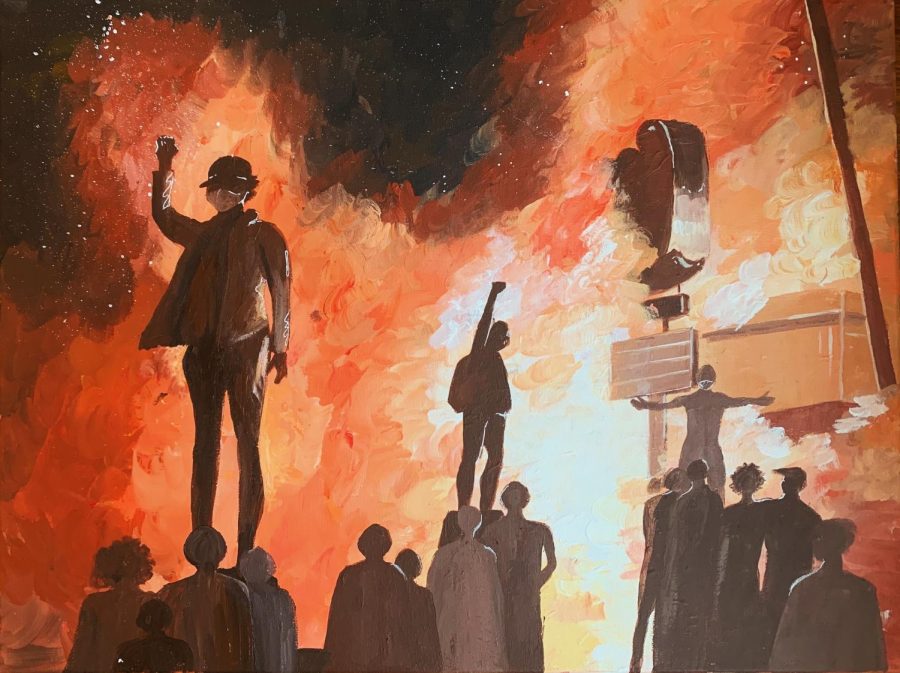
Junior Peter Fengler, who has been attending protests alongside Gach, said that it is important for young people to be involved in activism, as the youth generation is the future leadership of the country and the world.
“We need to know that our voices matter and our collective opinions are what makes change in our country today,” he said. “Our mindset should be open-mindedness and kindness and joy and love towards everyone because we’re all humans.”
Fengler said that he felt obligated to take part in the movement “because there’s obvious racial systematic oppression in our government today and just in our general laws.”
Senior Danny Nguyen also took to the streets over the summer, and said that he has been “trying to educate myself on different ways or different systems… that our world and our society oppresses Black people.”
Nguyen, as an Asian American, feels a certain solidarity with the challenges that the Black community faces, and thus feels that it is important that he stands with the BLM movement as an ally.
“As a person of color, and as a person who has been discriminated toward… I know what it feels like to be oppressed or to be discriminated against on the basis of your race and who you are as a person,” he said. “I feel like it’s my responsibility as a person of color to go to those protests and to be able to continue to learn and be able to understand the Black Lives Matter movement.”
Though junior Ava Whalon is not a person of color, she said that “I can only imagine how hard it would be to experience that type of racism, when it’s hard for me to even just read about it or see it in the media.”
Whalon described her experience at protests as “emotional,” “impactful,” and “moving,” and said that she wants to help the movement in any way she can — as a white person, she said, she has “more privilege and safety.”
“When suddenly there was this big movement that was so alive in our city, it just felt like of course the right thing to do would be to get involved,” she said.
Likewise, senior Abby Sheets said that she feels that attending protests is “the right thing to do.”
“As someone who’s not a person of color, I think if I was a part of the group being oppressed I would definitely want other people to be standing up with me, so it makes me feel good knowing that I can help those people get their voice heard,” she said. “Even though I’m just one person, it adds up if everyone stands with them too.”
Seniors Isa Sale and Anneliese Stahly-Dronkowski attended protests over the summer together, and both reflected on the concept of white privilege and their part in the BLM movement.
Sale said that because she is a white person living in the suburbs of a predominantly white city, she has been “sheltered” from the realities of systemic racism and police brutality, so she has been working to learn more about these topics.
She said that protesting is important because it makes a “disruption” and “[grabs] people’s attention.”
“For a lot of us, it’s easy to see the headlines, and that will be kind of the talk of the town for a couple days or a couple weeks, and then we can go back to our lives because we’re not directly affected by racism and by police brutality,” Sale said. “But I think continuing to make it something that people can’t ignore is really important.”
Several students described attending protests as an impactful experience. Fengler said that he feels a sense of community with those that he marches with, and Whalon said that it felt emotional to have “a space to sit there and imagine and reflect on how so many people are being mistreated in our country and kind of understand the weight of that.”
Ball said that she observed “really positive energy” when she attended protests and rallies.
“Everyone there — it doesn’t even matter if you know them — everybody will come up to you and they’ll be like, ‘We hear you and we see you and we’re in this together,’” Ball said.
But if you’ve paid any amount of attention to national news over the summer, “positive energy,” “community,” and “compassion,” as Ball and Fengler said, are not the descriptions that command the general narrative of the movement.
With the deployment of federal troops into Portland throughout July, and numerous clashes between protesters, counter-protesters, and law enforcement officials, as well as many instances of looting, rioting, and tear-gassing, themes of violence and conflict seemed to override those of peace and justice in the media.
After the Portland Police Bureau declared riots three times during the July Fourth weekend, Portland was portrayed as a “city under siege,” a chaotic scene of anarchy that was in need of reinforcement. However, the arrival of federal officers, who came armed with tear gas and impact munitions, brought further contention between demonstrators and officials — though there were also many uses of tear gas and allegations of police brutality during the times before and after the federal troops were in Portland.
“I think it’s an instance of trying to further silence the oppressed,” Stahly-Dronkowski said. “And I think that if people are using their voices and they’re coming out in large numbers, but they are peaceful, there’s no need to tear gas them, there’s no need to snatch them up on the street for simply just calling out things that we can fix.”
Although at a national level, the vast majority of protests were peaceful, there were many protesters this summer in Portland who did participate in acts of violence and destruction.
In addition to the many thousands of peaceful protesters who took to the streets of Portland, some shattered windows, vandalized buildings, and lobbed objects at police officers.
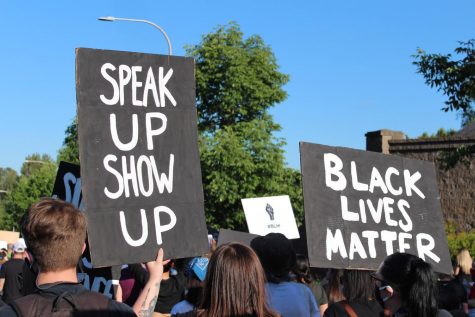
Even with the federal troops withdrawn from the city, conflicts continued throughout August, culminating on Aug. 29 when Aaron J. Danielson, a member of the right-wing group Patriot Prayer, was shot and killed downtown by an antifa supporter in a confrontation following the “Trump 2020 Cruise Rally,” which originated at Clackamas Town Center.
“No matter how we may differ, I don’t think that there’s ever an excuse for killing somebody,” Stahly-Dronkowski said in response to the killing of Danielson. “No matter how much I believe in equal rights and I fight for them, I never could justify hurting somebody because they’re a Trump supporter.”
As for other acts of destruction, such as looting and setting fire to buildings, Stahly-Dronkowski, Sale, and Sheets all said that they feel that they are not in a position to condemn Black protesters for such acts.
“I’m personally a person of nonviolence, but I think as a white person and [as] I’m not leading this movement, I’m simply supporting, I can’t tell people who are oppressed what’s the right and wrong way to protest,” Stahly-Dronkowski said. “That is their decision, and I’m not going to partake in those actions myself, and I’m just going to keep supporting in a peaceful manner… I wouldn’t do it, but I can’t tell them how to protest because I have a different experience in this world than they do.”
She also noted that many acts of violence, including throwing objects like rocks, bottles, fireworks, and cans at police officers, are often done by “white people who say they’re part of the movement.”
Sheets echoed this idea, and said that some people “just go there to start violence and cause problems.”
“I think that it really turns the protests into something they’re not, and kind of gets in the way of the message that the protests are trying to send,” she said. “When it gets to the point where it’s just covering up the message of what they’re trying to achieve — of equality and equity for people of color — it’s just not helpful to be violent towards [officers or counter-protesters], because they’re going to return it with more violence, and I think that’s just skewing the message a lot.”
Because of the various forms of violence that have occurred at these protests, as well as the tensions that run high between protesters and counter-protesters, Gach said that she has found herself in danger by simply attending BLM events.
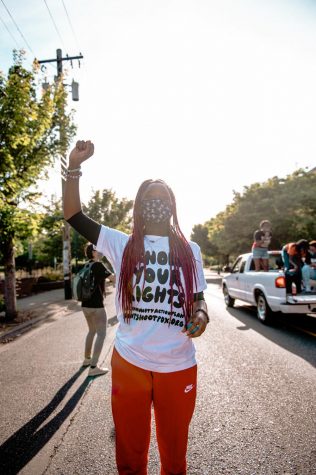
“By just doing all this, going down to protests, I’m putting my life on the line,” Gach said. “But I know it’s something that I need to do because I want to be treated the same as anyone else.”
Gach recounted how she was driving out of Clackamas Town Center during the pro-Trump rally, where a caravan of cars paraded through a route that began in Clackamas County and made its way to downtown Portland.
“People were trying to reach in my car, they were screaming the N-word at me, they were blowing diesel in my face,” she said. “I’m 16 years old, I’m a minor. People want to kill me. People don’t like me, and they don’t even know me.”
She said that members of the Trump rally tried to grab objects from inside of her car, and that when she tried to ask the security guard at Clackamas Town Center for help, “he just looked at me.”
“People who have a different view than me want to literally hurt me,” she said. “I don’t understand that because you don’t even know me — how would you want to hurt somebody you don’t even know? But they look at me and they just see the color of my skin. They don’t see who I am, and automatically I’m a bad person in their eyes.”
“People try and hurt me because I believe that Black lives matter [and] I believe my life is important,” she said. “It just doesn’t make any sense to me at all.”
Despite this, Gach said that she isn’t afraid, and that she won’t let fear stop her from advocating for what she believes.
“I understand that they probably want me to die, but I’m not scared of them,” she said. “If something does happen to me, at least I’m going to go down because of a good cause. At least I was trying to make a change.”
Junior Simon Abraha said that things would be in a much better place if “everybody was just nice” and “[treated] people how you want to be treated.”
“The most basic rule of all time,” he said. “Love others. Simple. That’s all I got to say.”
Gach also emphasized the importance of equitable treatment.
“We’re not different,” she said. “We’re all the same. I should be able to be held at the same standards as any other kid that does not look like me. I shouldn’t be judged for the color of my skin. I shouldn’t have people thinking that I’m not smart because I’m Black, that I have bad grades because I’m Black, that’s not what this is. I’m just the same as everyone else, [the] only thing is we look a little different, and that shouldn’t even be a problem.”
Coinciding with the movement for racial justice that took place nationwide throughout the summer were a number of equity-related changes within La Salle itself. Among these were the removal of the annual Better Together fundraiser from the month of February to reserve that time for focusing on Black History Month, a reassessment of curricula among staff members to strive for more equitable classroom experiences, and the creation of and hiring for a new position: a Director of Equity and Inclusion.
Ms. Kiah Johnson Mounsey, a 1999 La Salle graduate, was hired for this position, and spoke passionately in an interview with The Falconer about what she hopes to accomplish in this role.
She said that growing up in the Pacific Northwest as a person of color, she did not encounter many conversations around race, and this is part of the reason she wanted to get involved with equity work in education.
“I really wanted to be able to engage in this work, not only with students, but within the adult sector as well, to normalize these conversations and not make it taboo,” she said. “I think about how different my life would have been if those conversations were normalized, not only in my school life, but my outside life as well.”
Ms. Mounsey has been trained as an intercultural competency lead facilitator and has worked at Oregon Episcopal School for the past 13 years, where she worked most recently in the position of Youth Engagement Coordinator out of the office of inclusion and community engagement. She has also taught third grade, coached track and field and cross country, and instructed an eighth grade Health and Wellness class that was centered around identity and social justice.
At La Salle, Ms. Mounsey will work with the academic administrative team on programming and professional development, leading the school’s strategic work around diversity, equity, and inclusion.
“I think my history and having knowledge of the community, at least to a certain extent, will be helpful in guiding me,” she said. “I’m now in a position that I can incite change in a way that I wasn’t as a student.”
Interim Principal Ms. Alanna O’Brien said that Ms. Mounsey will not only work with teachers and administrators, but will also be involved with the student side of equity work, alongside Diversity, Equity, and Inclusion support Mr. Andrew Yoshihara.
“Part of the job is working with the adults in the community, specifically teachers, around professional development and curriculum work,” Ms. O’Brien said. “But also overseeing some student support around programming for students — whether that’s leadership responsibilities or other types of programming around our affinity groups… and bringing in speakers or looking for off-campus opportunities for students.”
Though she has some ideas and goals for her work at La Salle, Ms. Mounsey said that her first priority is to “engage in authentic and open conversations with people in the community” so as to to understand the experiences around race and equity that students, faculty, and parents have.
“I realize that it’s been many years since I’ve been a part of this community, and I want to hear what people have to say,” she said. “I want to hear their experience, I want to hear their thoughts, their questions, their ideas. And that’s really going to help guide me in my role and the work that I’m doing.”
***
Stay tuned to The Falconer in the coming weeks for additional reporting covering the Black Lives Matter movement, the events of this summer, and their impact within the La Salle community.


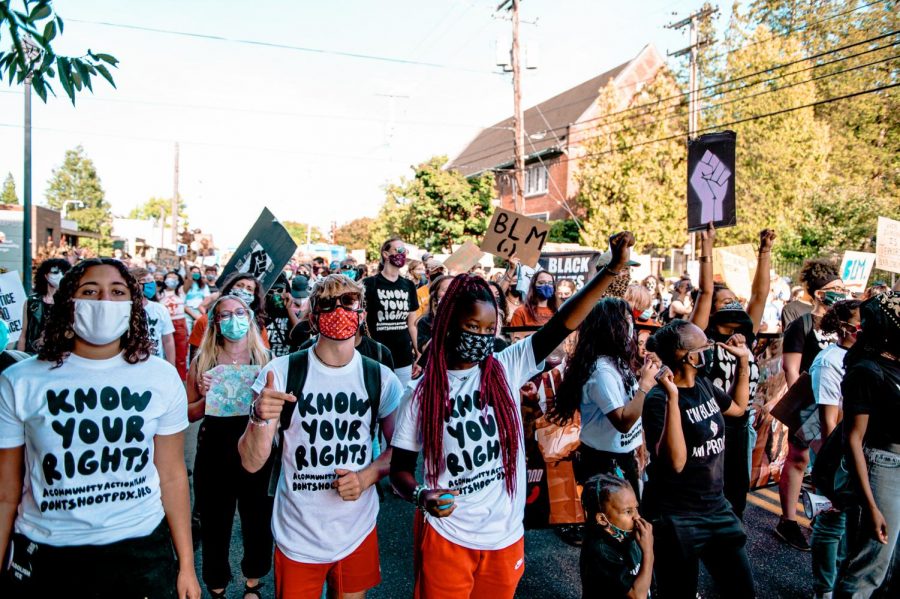
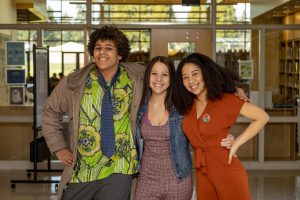
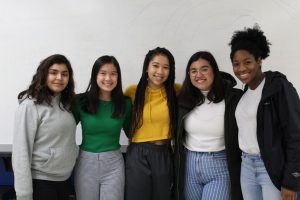
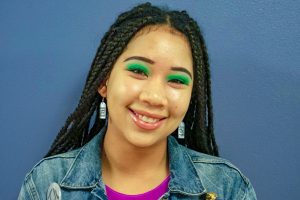
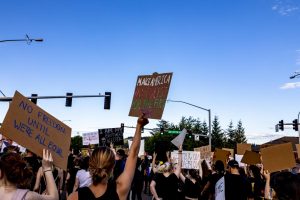
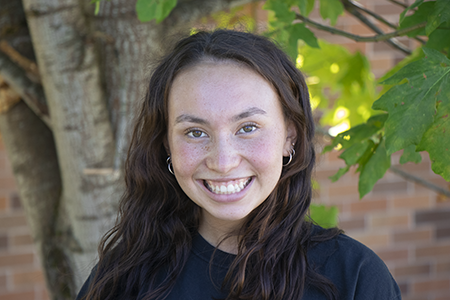



Tom McLaughlin • Oct 1, 2020 at 9:11 pm
What an impressive piece of writing, Maddie. Compelling, descriptive opening. And then you did a fabulous job of weaving together quotations from people you interviewed into a powerful, thought-provoking reflection on how members of our community are affected by and responding to this terrible crisis.
As for the students you interviewed, I am so proud of them. That you are diving into this work, putting yourself on the line, even risking your lives, as Ella pointed out, your commitment moves me. You are living the gospels. You are putting into action the essence of what I hope our Religious Studies courses are teaching. Thank you for modeling love under difficult circumstances.